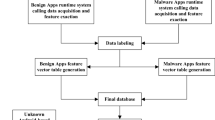Abstract
Malware is a section of code written with the intention of harming a device. Attacks on the Android operating system have been on the rise of late as there are plenty of applications on the Internet that possess malware. To analyze these attacks, machine learning can be used to make the process more efficient. This paper demonstrates static and dynamic analysis of Android malware. By identifying patterns from datasets created and using a myriad of classifiers, the results have been compared to infer the most optimal method of malware analysis. Various machine learning classifier algorithms are implemented, with Random Forest and Decision Tree giving the best accuracy and F1-Score of 94% in static analysis. Support Vector Machine and Neural Network have given the highest accuracies of about 99% after implementing Principal Component Analysis in dynamic analysis.
Access this chapter
Tax calculation will be finalised at checkout
Purchases are for personal use only
Similar content being viewed by others
References
Tupakula, U., Varadharajan, V., Akku, N.: Intrusion detection techniques for infrastructure as a service cloud. In: Ninth IEEE International Conference on Dependable, Autonomic and Secure Computing, pp. 744–751. IEEE (2011)
Mcafee.com.: McAfee Labs Threats Report (online) (2018). Available at: https://www.mcafee.com/enterprise/en-us/assets/reports/rp-quarterly-threats-dec-2018.pdf. Accessed 3 Feb. 2019
KOÇ, U.: Introduction to Android Malware Analysis. (Blog) Uceka (2013). Available at: https://uceka.com/2013/08/06/introduction-to-android-malware-analysis/. Accessed 18 Dec. 2018
Sahs, J., Khan, L.: A machine learning approach to android malware detection. In: European Intelligence and Security Informatics Conference, pp. 141–147. IEEE Computer Society (2012)
Arp, D., Spreitzenbarth, M., Hubner, M., Gascon, H., Rieck, K., Siemens, C.E.R.T.: Drebin: effective and explainable detection of android malware in your pocket. In: Ndss, vol. 14, pp. 23–26 (2014)
Aafer, Y., Du, W., Yin, H.: Droidapiminer: mining api-level features for robust malware detection in android. In: International Conference on Security and Privacy in Communication Systems, pp. 86–103. Springer, Cham (2013)
Allix, K., Bissyandé, T.F., Klein, J., Le Traon, Y.: Androzoo: Collecting millions of android apps for the research community. In: 2016 IEEE/ACM 13th Working Conference on Mining Software Repositories (MSR), pp. 468–471. IEEE (2016)
Android Malware Dataset. (n.d.). Android Malware Dataset (online). Available at: http://amd.arguslab.org. Accessed 15 Jan. 2019
Rana, M.S., Rahman, S.S.M.M., Sung, A.H.: Evaluation of tree based machine learning classifiers for android malware detection. In: International Conference on Computational Collective Intelligence, pp. 377–385. Springer, Cham (2018)
Urcuqui-López, C., Cadavid, A.N.: Framework for malware analysis in android. Sistemas Telemática 14(37), 45–56 (2016)
Willems, C., Holz, T., Freiling, F.: Toward automated dynamic malware analysis using cwsandbox. IEEE Secur. Priv. 5(2), 32–39 (2007)
Aung, Z., Zaw, W.: Permission-based android malware detection. Int. J. Sci. Technol. Res. 2(3), 228–234 (2013)
Desnos, A.: Androguard (2019)
Lashkari, A.H., Kadir, A.F.A., Gonzalez, H., Mbah, K.F., Ghorbani, A.A.: Towards a network-based framework for android malware detection and characterization. In: 2017 15th Annual Conference on Privacy, Security and Trust (PST), pp. 233–23309. IEEE (2017)
Choi, S., Bijou, M., Sun, K., Jung, E.: API tracing tool for android-based mobile devices. Int. J. Inf. Educ. Technol. 5(6), 460 (2015)
Feizollah, A., Anuar, N.B., Salleh, R., Wahab, A.W.A.: A review on feature selection in mobile malware detection. Digit. Inv. 13, 22–37 (2015)
Javadecompilers.com. (n.d.). APK Decompiler (online). Available at: http://www.javadecompilers.com/apk. Accessed 5 Feb. 2019
Geladi, P., Isaksson, H., Lindqvist, L., Wold, S., Esbensen, K.: Principal component analysis of multivariate images. Chemometr. Intell. Lab. Syst. 5(3), 209–220 (1989)
Jolliffe, I.: Principal Component Analysis, pp. 1094–1096. Springer, Berlin (2011)
Author information
Authors and Affiliations
Corresponding author
Editor information
Editors and Affiliations
Rights and permissions
Copyright information
© 2020 Springer Nature Singapore Pte Ltd.
About this paper
Cite this paper
Raghuraman, C., Suresh, S., Shivshankar, S., Chapaneri, R. (2020). Static and Dynamic Malware Analysis Using Machine Learning. In: Luhach, A., Kosa, J., Poonia, R., Gao, XZ., Singh, D. (eds) First International Conference on Sustainable Technologies for Computational Intelligence. Advances in Intelligent Systems and Computing, vol 1045. Springer, Singapore. https://doi.org/10.1007/978-981-15-0029-9_62
Download citation
DOI: https://doi.org/10.1007/978-981-15-0029-9_62
Published:
Publisher Name: Springer, Singapore
Print ISBN: 978-981-15-0028-2
Online ISBN: 978-981-15-0029-9
eBook Packages: Intelligent Technologies and RoboticsIntelligent Technologies and Robotics (R0)




